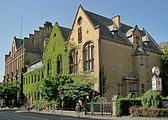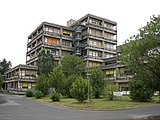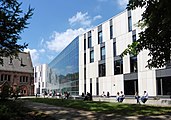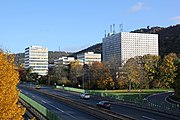| This article needs additional citations for verification. Please help improve this article by adding citations to reliable sources. Unsourced material may be challenged and removed. Find sources: "University of Marburg" – news · newspapers · books · scholar · JSTOR (February 2012) (Learn how and when to remove this message) |
| Philipps-Universität Marburg | |
 | |
| Latin: Schola Marpurgensis | |
| Type | Public |
|---|---|
| Established | 1 July 1527; 497 years ago (1527-07-01) |
| Budget | €335.6 million |
| Chancellor | Claas Cordes |
| President | Thomas Nauss |
| Academic staff | 2,657 |
| Administrative staff | 1,794 |
| Students | 22,380 |
| Location | Marburg, Hesse, Germany 50°48′39″N 8°46′25″E / 50.81083°N 8.77361°E / 50.81083; 8.77361 |
| Campus | University town |
| Affiliations | Compostela Group of Universities |
| Website | uni-marburg.de |
 | |
The Philipps University of Marburg (German: Philipps-Universität Marburg) is a public research university located in Marburg, Germany. It was founded in 1527 by Philip I, Landgrave of Hesse, which makes it one of Germany's oldest universities and the oldest still operating Protestant university in the world. It is now a public university of the state of Hesse, without religious affiliation.
The University of Marburg has about 23,500 students and 7,500 employees and is located in Marburg, a town of 76,000 inhabitants, with university buildings dotted in or around the town centre. About 14% of the students are international, the highest percentage in Hesse. It offers an International summer university programme and offers student exchanges through the Erasmus programme.
History
In 1609, the University of Marburg established the world's first professorship in chemistry. In 2012 it opened the first German interactive chemistry museum, called Chemicum. Its experimental course programme is aimed at encouraging young people to pursue careers in science. The university was among the first in Germany to offer courses in gender studies.
Nazi period
Main article: University education in Nazi Germany20 professors were expelled in 1933, among them economist Wilhelm Röpke, who emigrated, and linguist Hermann Jacobsohn, who committed suicide.
After 1945
Since the 1970s, the Department of Social Sciences has been regarded as a leftist stronghold, with Wolfgang Abendroth being a major influence within the field of political science in post-war Germany.
Academics
Research
The university is significant for its life-sciences research but is also home to one of the few centers that conduct research on the Middle East, the CNMS (Center for Near and Middle Eastern Studies). The departments of psychology and geography reached Excellence Group status in the Europe-wide CHE Excellence Ranking 2009.
Its research is illustrated by its participation in several SFBs (Sonderforschungsbereiche). These collaborative research centres are financed by the German Science Foundation DFG. They encourage researchers to cross the boundaries of disciplines, institutes, departments and faculties within the participating university. The current SFB at Philipps-University Marburg are:
- SFB/TR17 – Ras-dependent Pathways in Human Cancer (started 2004; with Julius-Maximilians-Universität Würzburg)
- SFB/TR22 – Allergic response of the lung (started 2005, with Research Center Borstel and LMU Munich)
- SFB/TR81 – Chromatin Changes in Differentiation and Malignancies (started 2010, with Justus-Liebig Universität Gießen)
- SFB-TRR 84 – Innate Immunity of the Lung (started 2010, with Charité Universitätsmedizin Berlin, FU Berlin, Robert-Koch-Institut, Max-Planck-Institut für molekulare Genetik, Max-Planck-Institut für Kolloid- und Grenzflächenforschung, Justus-Liebig-University Gießen)
- SFB-TRR 135 – Cardinal mechanisms of perception (started 2014, with Justus-Liebig Universität Gießen)
- SFB 593 – Mechanisms of cellular compartmentalisation and the relevance for disease (started 2003)
- SFB 987 – Microbial Diversity in Environmental Signal Response (started 2012, with Max Planck Institute for Terrestrial Microbiology, Marburg)
- SFB 1083 – Structure and Dynamics of Internal Interfaces (started 2013, with Donostia International Physics Center San Sebastián, Spain)
- SFB 1021 – RNA viruses: RNA metabolism, host response and pathogenesis (started 2013, with Justus-Liebig Universität Gießen)
Collections of the university
- Alter Botanischer Garten Marburg, the university's old botanical garden
- Botanischer Garten Marburg, the university's current botanical garden
- Forschungsinstitut Lichtbildarchiv älterer Originalurkunden bis 1250 (Collection of photographs taken from medieval charters)
- Bildarchiv Foto Marburg (German national picture archive of arts)
- Religionskundliche Sammlung (Collection of religious objects)
- Deutscher Sprachatlas (Linguistic Atlas of Germany)
- Mineralogisches Museum (Museum of Mineralogy)
- Museum für Kunst und Kulturgeschichte (Museum of Arts)
- Museum Anatomicum(Museum of Anatomy and Medical History)
Rankings
| University rankings | |||||||||||||||||||
|---|---|---|---|---|---|---|---|---|---|---|---|---|---|---|---|---|---|---|---|
| Overall – Global & National | |||||||||||||||||||
| |||||||||||||||||||
As per the QS World University Rankings of 2024, the institution is situated within the 761–770 range globally, and it holds the 40–41 position nationally. According to the THE World University Rankings of 2024, it ranks within the 401–500 bracket globally, while its national standing falls between 37 and 41. In the ARWU World Rankings of 2023, the university is listed in the 401–500 range worldwide, and it takes a national position between 25 and 31.
Gallery
-
 Department of Economics
Department of Economics
-
 Department of Psychology
Department of Psychology
-
 The Lahnberge Campus is dedicated to the natural sciences. The image shows the Multiple Purpose Building, home of the Departments of Mathematics and Computer Science, as well as laboratories for research into material sciences and physical chemistry
The Lahnberge Campus is dedicated to the natural sciences. The image shows the Multiple Purpose Building, home of the Departments of Mathematics and Computer Science, as well as laboratories for research into material sciences and physical chemistry
-
 The building of the nearby Biology Department is of the same architectural style
The building of the nearby Biology Department is of the same architectural style
-
 The University Hospital along with the Department for Medical Studies is also located at the Lahnberge Campus
The University Hospital along with the Department for Medical Studies is also located at the Lahnberge Campus
-
 The Old University, housing the university church, the department for religious studies and a representative lecture hall
The Old University, housing the university church, the department for religious studies and a representative lecture hall
-
 The administrative headquarters of the university
The administrative headquarters of the university
-
 The Central Lecture Hall Building, which has been built to cater for the increased number of students
The Central Lecture Hall Building, which has been built to cater for the increased number of students
-
 University library
University library
-
 University of Marburg - Department of Social Sciences and former University library
University of Marburg - Department of Social Sciences and former University library
-
 One of the two large university cafeterias and canteens is located on the bank of the Lahn river
One of the two large university cafeterias and canteens is located on the bank of the Lahn river
Notable alumni and faculty
Natural scientists
- Ludwig Aschoff
- Emil von Behring
- Karl Ferdinand Braun
- Klaus Bringmann
- Robert Bunsen
- Adolf Butenandt
- Georg Ludwig Carius
- Stefanie Dehnen
- Franz Ludwig Fick
- Hans Fischer
- Edward Frankland
- Frederick Augustus Genth
- Johann Peter Griess
- Juan Gundlach
- Karl Eugen Guthe
- Otto Hahn
- Johannes Hartmann
- Thomas Archer Hirst
- Erich Hückel
- Kathrin Jansen
- Manfred Klüppel
- Hermann Knoblauch
- Hermann Kolbe
- Albrecht Kossel
- Ulrich Lemmer
- Otto Loewi
- Carl Ludwig
- Hans Meerwein
- Ludwig Mond
- Denis Papin
- Heinrich Petraeus
- Otto Schindewolf
- Thorsten M. Schlaeger
- Sunao Tawara
- John Tyndall
- Wilhelm Walcher
- Alfred Wegener
- Georg Wittig
- Alexandre Yersin
- Karl Ziegler
- Theodor Zincke
- Adolf Fick
Theologians
Marburg was always known as a humanities-focused university. It retained that strength, especially in Philosophy and Theology for a long time after World War II.
- Rudolf Bultmann
- Karl Barth
- Andreas Leonhard Creuzer [de]
- Friedrich Heiler
- Wilhelm Herrmann
- Aegidius Hunnius
- Andreas Hyperius
- Otto Kaiser
- Helmut Koester
- Jacob Lorhard
- Rudolf Otto
- Johann Jakob Pfeiffer
- Kurt Rudolph
- Annemarie Schimmel
- Paul Tillich
- August Friedrich Christian Vilmar
- Gottlieb Olpp – on medical missionary
Philosophers
- Wolfgang Abendroth
- Hannah Arendt
- Karl Theodor Bayrhoffer
- Ernst Cassirer
- Hermann Cohen
- Hans-Georg Gadamer
- Nicolai Hartmann
- Martin Heidegger
- Hans Heinz Holz
- Hans Jonas
- Friedrich Albert Lange
- Karl Löwith
- Paul Natorp
- José Ortega y Gasset
- Isaac Rülf
- Leo Strauss
- Christian Wolff
- Eduard Zeller
- Jochen Ropke
Other
Alumni
- Kunigunde Bachl
- Hermann Behrends (1907–1948), German Nazi SS officer executed for war crimes
- Gottfried Benn
- Gerold Bepler
- Jessie Forbes Cameron (1883–1968)
- Georg Friedrich Creuzer
- T. S. Eliot (who had to quit a summer school in August 1914, at the start of World War I)
- Johannes Goddaeus
- Jacob Grimm
- Wilhelm Grimm
- Caspar Friedrich Hachenberg
- Gustav Heinemann
- de:Jost Hermand
- Beatrice Heuser
- Stefan Hofmann
- Kim Hwang-sik
- Wilhelm Liebknecht
- Mikhail Lomonosov
- Carlyle Ferren MacIntyre
- Ulrike Meinhof
- Friedrich Paulus
- Boris Pasternak
- Ernst Reuter
- Ferdinand Sauerbruch
- Friedrich Carl von Savigny
- Heinrich Schütz
- Moritz Schuppert
- Manfred Siebald
- Wilhelm Röpke
- Costas Simitis
- Jack Thiessen
- Dmitry Ivanovich Vinogradov
- Richard Wiese (linguist)
See also
- List of early modern universities in Europe
- List of universities in Germany
- University hospital Giessen und Marburg
Notes
- "Katalog der Deutschen Nationalbibliothek". Deutsche Nationalbibliothek (in German). Leipzig and Frankfurt, Germany. Archived from the original on 28 November 2024. Retrieved 28 November 2024.
- "Aktuelle Zahlen auf einen Blick". University of Marburg (in German). Retrieved 21 June 2017.
- "Claas Cordes wird neuer Kanzler der Universität Marburg". University of Marburg (in German).
- ^ "Employees". Retrieved 20 April 2017.
- "Studierendenstatistik" (PDF). www.uni-marburg.de (in German). Universität Marburg. 2021–22. Retrieved 9 April 2023.
- "Uni International – Philipps-Universität Marburg". Retrieved 21 July 2015.
- ""Chemikum Marburg" hat ein dauerhaftes Domizil". Informationsdienst Wissenschaft e.V. online. 12 February 2011. Retrieved 23 January 2012.
- "Professor Kills Self".
- "Sonderforschungsbereiche – Philipps-Universität Marburg". Retrieved 9 May 2020.
- "Research Center Deutscher Sprachatlas". Retrieved 1 August 2024.
- ^ "QS World University Rankings 2024". QS World University Rankings. Retrieved 16 July 2023.
- ^ "World University Rankings 2024". Times Higher Education World University Rankings. 27 September 2023. Retrieved 27 September 2023.
- ^ "2023 Academic Ranking of World Universities". Academic Ranking of World Universities. Retrieved 15 August 2023.
- "Hessische Biografie : Erweiterte Suche : LAGIS Hessen". www.lagis-hessen.de (in German). Retrieved 29 November 2018.
- "Knochenmetastasen bei Mammacarcinom" [Bone Metastases in Breast Cancer]. German National Library (in German). 1947. Retrieved 24 July 2023.
External links
- Official website
 (in German and English)
(in German and English)